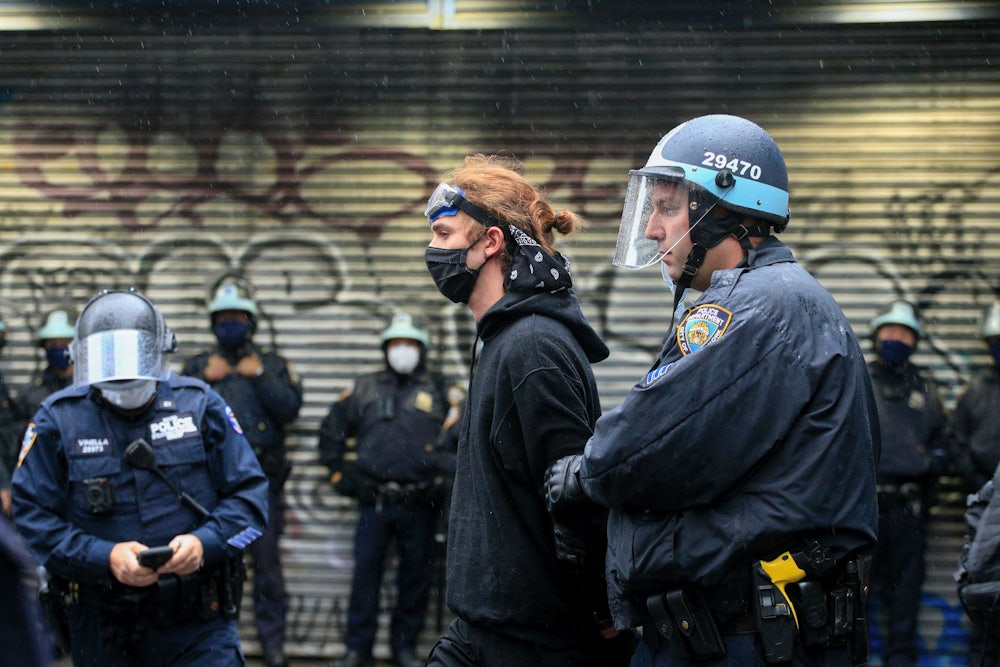Kettling is, by definition, a trap. It is a tactic most commonly used by police to surround and immobilize a group of people, often protesters, in an attempt to stymie and diffuse their momentum, even if unnecessary.
On Wednesday night, as the election count crawled past the 24-hour mark, anti-Trump protesters in New York had committed no crime other than briefly holding up traffic in Manhattan and shaking some street signs. For all of the public concern shown by Manhattan businesses boarding up their storefronts over the weekend, there was very little by way of physical destruction committed by the protesters, save for a handful of trash can fires. Nonetheless, New York police officers kettled the hell out of the group. They surrounded them, using their bikes as a barrier, then slowly moved in, throttling whoever they could get their hands on and tossing them to the ground and then into vans. When it was all finished, a dozen people had been arrested. NYPD Chief Terence Monahan told The New York Times afterward, “My message to anyone who wants to cause violence and destruction is, don’t even try it.” His department, it seems, must have skimmed the memo.
Other protests come with a different story. In Detroit, Trump supporters flocked inside polling precincts and accosted poll workers, trying to halt their operations. Across the country, only one of these groups was consistently aiming to suppress the vote, yet this was not the group that was met with a violent police response. This is not a novel discovery—we have a summer’s worth of evidence, and centuries worth of a terrible country, making this plain. But to see this dynamic play out against the backdrop of an election made it crystal clear, once again, what side the cops are on, what they perceive as a threat, and where they see their interests being expressed—or challenged—on the streets.
In Maricopa County, Arizona, roughly 300 Trump supporters surrounded the Recorders Office, with several even entering the building before being asked to leave. Outside, one supporter waved a Trump flag, while another spoke through a bullhorn at police officers standing just a few feet away, demanding to know who was counting the votes. Some of those in the crowd were openly carrying guns. No arrests were made, and the police somehow managed not to kettle the group. In Detroit, another large group of ballot challengers, some not wearing masks despite a state mandate, stood both outside and inside the TCF Center, where ballots were being tallied, repeatedly chanting, “Stop the count.” Again, no arrests; no kettling.
Meanwhile, in New York, Portland, Minneapolis, and Denver, police hit the streets on a mission. After protesters peacefully marched down I-94 in Minneapolis to protest Trump’s demand to cease ballot counting, police, decked out in riot gear, refused to let them exit the freeway and return to their homes, blocking the exit and having everyone sit on the asphalt so that they could issue over 600 arrests. In Denver, anti-Trump protesters burned a Trump flag while they marched through the city. In total, a couple of broken glass windows and another trash fire were the two biggest offenses. Police hit back with pepper balls and tear gas, and eight people were arrested.
The unrest in the face of an election this contentious was expected. Police, like any other person that knew Election Day was slated for November 3, understood that protests and marches would likely ensue. They also knew, or should have, that election centers would be a hotbed for those looking to contest or halt ballot-counting operations. So the discrepancy in their response to these public disruptions feels less like a random outcome and more like the result of an established culture of siding with the group that is frequently more friendly and heavily armed. In an investigation published earlier this week, Times reporters, reviewing hundreds of videos from the summer protests following the police killing of George Floyd, found that “at times, police officers gave the benefit of the doubt to armed far-right groups and individuals, which can embolden vigilantes and lead to violence.”
If Trump supporters and their fellow purported far-right patriots are protesting, there’s little incentive for police to treat them the same as they would a Black Lives Matter march or an anti-Trump contingent, because that would be burning their natural allies. This is horrifying for all kinds of reasons. It’s also why more towns and cities, like Los Angeles, are proving to be fertile ground for successful grassroots campaigns looking to divert funds from police departments and toward services that actually help the community.
Because why let an institution cannibalize money for health care and housing just so it can turn around and club you for having the audacity to protest a president who says he wants to steal an election?
